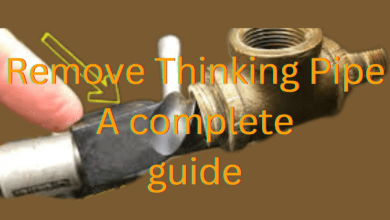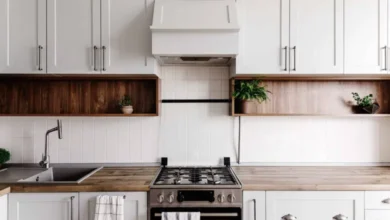The Best Kitchen Tools for Removing Rust from Steel

Removing Rust from Steel kitchen tools is a nuisance to any home cook. It affects not only the appearance of one’s favourite knives, forks, and cookware but also their usability and safety. Fortunately, rust on steel tools can be removed—it’s easy! In this step-by-step guide, we will demonstrate how to remove rust from steel kitchen tools, provide recommendations for their further treatment and protective measures, and stress the need for such routine care.
Knowing the Cause of Rusting
Rusting results from a natural process known as oxidation, which occurs when there is moisture, iron, and oxygen. Iron oxide is commonly referred to as rust. Stainless steel is made to be rustproof because it contains chromium. However, corrosion can occur on the stainless material where optimum conditions are maintained, and constant wetting and drying are practised.
Rust Types
An understanding of the types of rust helps assess the best way to get rid of the rust present in steel:
- Surface Rust: Surface rust is the most shallow form of rust. It can often be seen as a thin reddish-brown film on the surface of the steel. This type does not penetrate very deeply into the material and is not hard to clean off.
- Pitting Rust: Pitting rust is another, even more advanced type of corrosion that forms small pits or holes in steel surfaces. Removing pitting rust is complex and may include sanding, grinding, etc.
- Scale rust occurs when rust grows into a thicker crust and starts composing into large, flaky pieces. This state of the metal more often suggests extensive and severe corrosion and might require professional intervention.
Safety Precautions
It is also essential to state that the safety of the individuals must be considered first before cleaning any metallic surface. Always wear gloves to cover your hands and goggles to protect your face from rust, dust, and water used for cleaning. As an extra measure, be aware that your working area is well-aerated, especially when using chemical cleaners.
Additional Safety Tips:
- Rubbing pads, which can damage the surfaces of the conducting tools, should not be used.
- If you use commercial rust removers, do not use them in the kitchen if the instructions state that they are contraindicated for kitchen use.
Basic Rust Removal Techniques
Various techniques discussed below will help you remove the rust from the steel utensils in your kitchen using some essential household items.
A. Baking Soda Paste
Baking soda is a common home ingredient that can be handy when removing rust from steel.
What You Need:
Two tablespoons of baking soda and one tablespoon of water
Instructions:
- Combine baking soda and water to form a paste of suitable consistency.
- Apply this paste liberally on all the rusty parts of your steel tools.
- Give it 30 minutes to 1 hour to work since the baking soda will help dislodge the rust.
- Gently rub the area with a cloth or sponge. The rust ought to come off with relative ease.
- Rinse the tools in running water and dry them promptly to prevent surface rust from developing.
- The technique works best on mild surface rust and works perfectly with kitchen tools made of steel.
B. Vinegar Soak
Vinegar is a straightforward way to remove rust from steel tools.
Instructions:
- Take a bowl containing white vinegar and cover all tools in white vinegar.
- After soaking, use a soft bristle brush or cloth to remove the rusted portions. The vinegar’s acidity will quickly eliminate the rust.
- Withdraw liquid and moisture thoroughly into the cells, causing no water to be present inside.
- Specific vinegar is a standard method because it is safe and not harmful to the environment.
C. Lemon Juice and Salt
For naturalists, lemons combined with salt can be a better remedy for removing rust from steel.
Instructions:
- Pour a lot of salt on the afflicted areas with rust.
- Squeeze in some lemon juice and sufficient juice until the salt is saturated.
- Leave the mixture on the affected area for a couple of hours so the salt and acid can dissolve the rusty area.
- Lightly scrub the afflicted area using a cloth or sponge, wash off the area, and dry it thoroughly.
- Certain types of rust removers are predominantly used for this purpose. Lemon juice contains citric acid, which dissolves the rust, and salt scrubs off the rust particles.
Innovative Methods of Removing Rust
At times, rust seems to wash away, or it has advanced so far that ingenious methods of scraping the steel rust away will be needed.
A. Commercial Rust Removers
Commercial rust removers are recommended for severe rust if you consider removing the rust from a given piece of steel in a few minutes.
Instructions:
- Select a proud CT, specifically a rust remover (recommended Evapo-Rust and Rust-Oleum breath.).
- Read the instructions on the labels to use the product properly and safely.
- Once the product has been applied, leave it on the rusted area for the specified time, usually 10 minutes to a few hours.
- After the listed time, wipe away any excess product and rinse out all the coated surfaces.
- Most of these products contain strong acids that can penetrate the rust havers and clean them out quickly, but always check if they are ok to use in the kitchen.
B. Sanding and Grinding
Sanding may also eliminate the rust in all steel tools in cases of heavy rust.
Instructions:
- Use coarse sandpaper and grinding equipment to focus on the rusty areas.
- Carefully sand it off with the rest of the rust to expose the clean surface. Do not sand too much, as this may damage the tool further.
- Rough sanding would have been completed, so clean the area where the rust has been removed and, if possible, paint the entire protective coating on the tool to prevent it from rusting again.
- This method can restore the original appearance of rusty and damaged tools, but it may require more effort and time than other methods.
Preventing Rust in the Future
Last but not least, after cleaning steel tools of all rust, you must take good care of them to prevent rust from occurring again.
Are Completeness-Approved Before Drying: Steel tools must be dried after every wash. A quick towel-dry will drastically reduce water moisture. A microfiber cloth that absorbs water quickly may be a better choice.
Immediately after cleaning, rationally store your tools in a non-humid place. They should not be kept in the sink in high humidity. A knife block or magnetic strip would be ideal since they restrict the chances of moisture and contact with other metal surfaces.
Applying some coatings, such as food-grade mineral oil or silicone, easily avoids moisture accumulation. After cleaning, a good rust preventive measure is wiping all your tools with a biplane surface.
Additional Maintenance Tips.
All the tools should be checked frequently for signs of rust or wear and tear, and any such concerns should be addressed immediately.
Do not submerge steel tools in water for a long time; they will rust faster than if they were not submerged.
For regular dirt, a three-foot clean for rust-resistant steel.
Conclusion
Removing rust from steel kitchen utensils is not such a worrying exercise. With the application of these simple techniques, the shape and function of the items in the kitchen can be enhanced. Proper care and storage of the equipment have many years of usefulness without the frustration of rust while cooking.
Methods for Clearing Rust Off Steel Kitchen Tools
Introduction
Rust on steel kitchen tools is a nuisance to any home cook. It affects not only the appearance of one’s favourite knives, forks, and cookware but also their usability and safety. Fortunately, rust on steel tools can be removed, and it’s relatively easy! In this step-by-step guide, we will demonstrate how to remove rust from steel kitchen tools, provide recommendations for their further treatment and protective measures, and stress the need for such routine care.
Knowing the Cause of Rusting
Rusting results from a natural process known as oxidation, which occurs when there is moisture, iron, and oxygen. Iron oxide is commonly referred to as rust. Stainless steel is made otherwise to be rustproof because it contains chromium. Corh corrosion can occur on the stainless material where optimum conditions are maintained, and constant wetting and drying are practiced.
Rust Types
Understanding the types of rust helps assess the best way to remove rust from steel.
Surface Rust: Surface rust is the most shallow form of rust. It usually appears as a thin reddish-brown film on the surface of the steel. This type does not penetrate very deep into the material and is not hard to clean off.
Pitting Rust: Pitting rust is another more advanced type of corrosion that forms small pits or holes in steel surfaces. Removing pitting rust is complex and may involve sanding, grinding, etc.
Scale rust occurs when rust grows into a thicker crust and starts composing into large, flaky pieces. This state of the metal more often suggests extensive and severe corrosion and might require professional intervention.
Safety Precautions
It is also essential to state that before cleaning any metallic surface, the safety of the individuals must be put first. It is mandatory always to wear gloves to cover your hands and goggles to protect your face from rust, dust, and water, which are used for cleaning. As an extra measure, be aware that your working area is well-aerated, especially when using chemical cleaners.
Additional Safety Tips:
Rubbing pads, which can damage the surfaces of the conducting tools, should not be used.
If you use commercial rust removers, do not use them in the kitchen if the instructions state that they are contraindicated for kitchen use.
Basic Rust Removal Techniques
Various techniques discussed below will help you remove the rust from the steel utensils in your kitchen using some essential household items.
A. Baking Soda Paste
Baking soda is a common home ingredient that can be handy when removing rust from steel.
What You Need:
Two tablespoons of baking soda and one tablespoon of water
Instructions:
Combine baking soda and water to form a paste of suitable consistency.
Apply this paste liberally on all the rusty parts of your steel tools.
Give it 30 minutes to 1 hour to work since the baking soda will help dislodge the rust.
Gently rub the area with a cloth or sponge. The rust ought to come off with relative ease.
Make sure to rinse the tools in running water and dry them promptly so there is no chance of surface rust developing.
The technique works best on mild surface rust and works perfectly with kitchen tools made of steel.
B. Vinegar Soak
Vinegar is a straightforward method for removing rust from steel tools.
Instructions:
Take a bowl containing white vinegar and put in the rusted tools, completely covering them in white vinegar.
After soaking, use a soft bristle brush or cloth to remove the rusted portions. The vinegar’s acidity will quickly eliminate the rust.
Withdraw liquid and moisture thoroughly into the cells, causing no water to be present inside.
Specific vinegar is a standard method that is safe and not harmful to the environment.
C. Lemon Juice and Salt
For naturalists, lemon juice combined with salt can be a better remedy for removing rust from steel.
Instructions:
Pour a lot of salt on the afflicted areas with rust.
Squeeze in some lemon juice and sufficient juice until the salt is saturated.
Leave the mixture on the affected area for a couple of hours so the salt and acid can dissolve the rusty area.
Lightly scrub the afflicted area using a cloth or sponge, wash off the area, and dry it thoroughly.
Certain types of rust removers are predominantly used for this purpose. Lemon juice contains citric acid, which dissolves the rust, and salt scrubs off the rust particles.
Innovative Methods of Removing Rust
At times, rust seems to wash away or has advanced so far that ingenious methods of scraping the steel rust away will be needed.
A. Commercial Rust Removers
In cases of severe rust, a commercial rust remover is recommended for people considering the removal of a given steel’s rust in a couple of minutes.
Instructions:
Select a product, specifically a rust remover (recommended Evapo-Rust and Rust-Oleum brands).
Read the instructions on the labels to use the product properly and safely.
Once the product has been applied, leave it on the rusted area for the specified time, generally 10 minutes to a few hours.
After the listed time, wipe away any excess product and rinse out all the coated surfaces.
Most of these products contain strong acids that can penetrate the rust havers and clean them out quickly, but always check if they are ok to use in the kitchen.
B. Sanding and Grinding
Sanding may also eliminate the rust in all steel tools in cases of heavy rust.
Instructions:
Use some coarse sandpaper and grinding equipment, focusing on the rusty areas.
Carefully sand it off with the rest of the rust to expose the clean surface. Do not sand too much, as this may damage the tool further.
Rough sanding would have been completed, so clean the area where the rust has been removed and, if possible, paint the entire protective coating on the tool to prevent it from rusting again.
This method can restore the original appearance of rusty and damaged tools, but it may require more effort and time than other methods.
Preventing Rust in the Future
Last but not least, after cleaning steel tools of all rust, you must take good care of them to prevent rust from occurring again.
Are Completeness-Approved Before Drying: Steel tools must be dried after every wash. A quick towel-dry will drastically reduce water moisture. A microfiber cloth designed to absorb water easily may be a better choice.
Immediately after cleaning, rationally store your tools in a non-humid place. They should not be kept in the sink in high humidity. A knife block or magnetic strip would be ideal since they restrict the chances of moisture and contact with other metal surfaces.
Applying some coatings, such as food-grade mineral oil or silicone, easily avoids moisture accumulation. After cleaning, moisturizer is wiped with a biplane surface on all of them.
Additional Maintenance Tips.
All the tools should be checked frequently for signs of rust or wear and tear, and any such concerns should be addressed immediately.
Do not submerge steel tools in water for a long time; they will rust faster than if submerged.
A three-foot cleaner will be used for regular dirt and rust-resistant steel.
Conclusion
Removing rust from steel kitchen utensils is not a worrying exercise. These simple techniques can enhance the shape and function of kitchen items. Proper care and storage of the equipment can ensure many years of usefulness without the frustration of rust while cooking.




